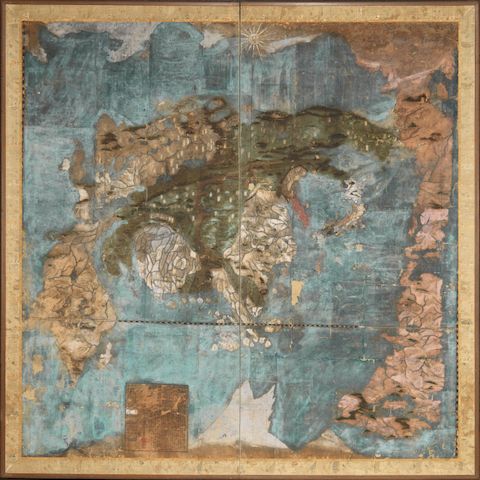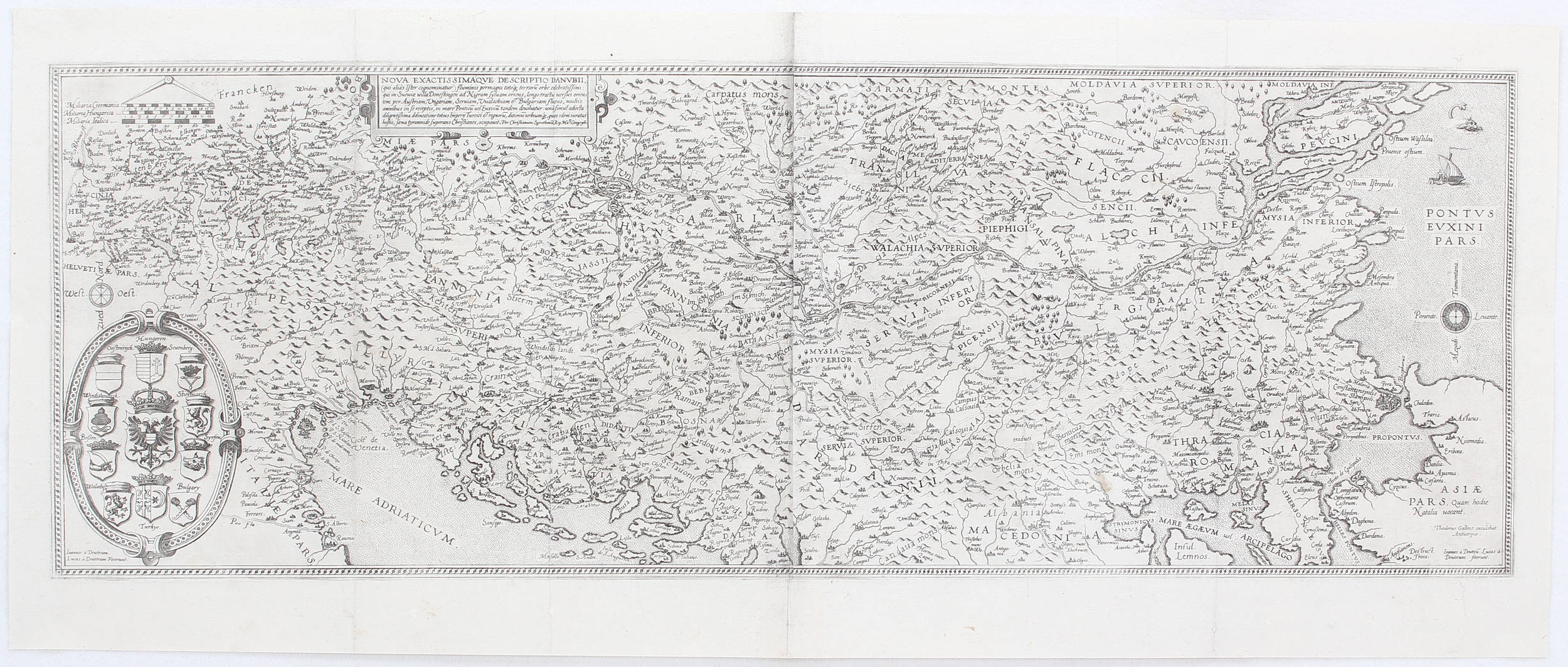BLAEU, Willem (1571-1638). [Four Continents]: Africa: [Nova & Acurata Totius Africae Tabula]; North & South America: [Nova Acurata Totius Americae Tabula]; Asia: [Nova & Acurata Totius Asiae Tabula]]; Europe: [Nova Acurata Totius Europae Tabula]. Bologna, Pietro Todeschi, [1673, or later]. Extremely rare, a complete set of Blaeu’s iconic wall maps of the four continents. The pinnacle of Dutch Golden Age decorative cartography, Blaeu’s wall maps occupied a prominent place in Dutch culture as indicators of both affluence and intellectual curiosity, demonstrated by their appearance in several of Johannes Vermeer’s paintings. The leading scholar and scientist, Constantijn Huygens (1596-1687), remarked how he employed his own set of Blaeu’s wall maps of the continents as a tool to enlighten his children: ‘To encourage them even more, I had the four parts of the world by Willem Blaeu mounted in my entrance hall, where they often played, in order to provide them with a fixed image of the world and its division’. Between 1594-1596, Blaeu studied under the eminent Danish astronomer Tycho Brahe, refining his skills in instrument- and globe-making. Upon his return to Amsterdam, he established the Officina Blaviana, selling maps, globes, scientific instruments, and editing and publishing the works of intellectuals such as Descartes and Grotius. He was extremely successful in a very competitive cartographic market, and to establish his pre-eminence engaged the important cartographer Hessel Gerritsz (1580-1632), and the skilled engraver Joshua van de Ende (b.1583/4) to produce a set of the most accurate wall maps of the continents possible. The first edition was produced in 1608, and a further issue was published in 1612. Eventually the plates found their way to Hendrik Hondius who published an edition in 1624, and finally passing to Nicholas Visscher, who employed them in 1655-7. All editions of Blaeu wall maps are extreme rarities, with only one incomplete set of the 1608 original surviving (missing the map of Africa), having been discovered in Switzerland in 1979. The popularity of Blaeu’s maps was such that they were pirated in Italy and France. The Venetian printer Stefano Mozzi Scolari (1598-1650) produced a version in about 1646, and it is from this publication that the present lot is derived, engraved by Pietro Todeschi in Bologna in the early 1670s and published in 1673, probably by Giuseppe Longhi (Schilder). Sets of these are rare in themselves: we have only been able to find the following institutional examples: Library of Congress (2 examples); Harry Ransome Center, UT, Austin; Royal Geographical Society, London; Luneburg Museum, Germany; Societa Geografica Italiana, Rome; Koninklijke Hollandsche Lloyd, Amsterdam (untraced); Biblioteca Apostolica Vaticana. AMERICA: ‘One of the most influential maps of America ever made’ (Burden I, 156). Blaeu and Gerritsz acquired advanced sources, and while the largely unexplored Pacific coast of North America extends to too far to the west, the overall proportions of the continent are well assured for the time. Over to the Atlantic, Nova Scotia has taken shape, based on the voyages of Samuel de Champlain and Pierre Gua de Monts from 1604. New England is less defined indicating that intelligence of the English reconnaissance of the region in 1602 had not yet reached Amsterdam, while the depiction of the southeast is quite advanced. The width of South America is overly attenuated, consistent with all maps of a period in which the determination of longitude was an inexact science. The Todeschi edition can be differentiated from other editions by a few changes in toponyms, and as Burden notes: ‘One notable deviation from all those before is an attempt to correlate the map with the California as an island theory. This was achieved by creating an island out of Baja California’ (Burden II, 433). On the inset map of the Great Southern Continent ‘is the name Stretto Lamairo. The drawing of a coastlin
BLAEU, Willem (1571-1638). [Four Continents]: Africa: [Nova & Acurata Totius Africae Tabula]; North & South America: [Nova Acurata Totius Americae Tabula]; Asia: [Nova & Acurata Totius Asiae Tabula]]; Europe: [Nova Acurata Totius Europae Tabula]. Bologna, Pietro Todeschi, [1673, or later]. Extremely rare, a complete set of Blaeu’s iconic wall maps of the four continents. The pinnacle of Dutch Golden Age decorative cartography, Blaeu’s wall maps occupied a prominent place in Dutch culture as indicators of both affluence and intellectual curiosity, demonstrated by their appearance in several of Johannes Vermeer’s paintings. The leading scholar and scientist, Constantijn Huygens (1596-1687), remarked how he employed his own set of Blaeu’s wall maps of the continents as a tool to enlighten his children: ‘To encourage them even more, I had the four parts of the world by Willem Blaeu mounted in my entrance hall, where they often played, in order to provide them with a fixed image of the world and its division’. Between 1594-1596, Blaeu studied under the eminent Danish astronomer Tycho Brahe, refining his skills in instrument- and globe-making. Upon his return to Amsterdam, he established the Officina Blaviana, selling maps, globes, scientific instruments, and editing and publishing the works of intellectuals such as Descartes and Grotius. He was extremely successful in a very competitive cartographic market, and to establish his pre-eminence engaged the important cartographer Hessel Gerritsz (1580-1632), and the skilled engraver Joshua van de Ende (b.1583/4) to produce a set of the most accurate wall maps of the continents possible. The first edition was produced in 1608, and a further issue was published in 1612. Eventually the plates found their way to Hendrik Hondius who published an edition in 1624, and finally passing to Nicholas Visscher, who employed them in 1655-7. All editions of Blaeu wall maps are extreme rarities, with only one incomplete set of the 1608 original surviving (missing the map of Africa), having been discovered in Switzerland in 1979. The popularity of Blaeu’s maps was such that they were pirated in Italy and France. The Venetian printer Stefano Mozzi Scolari (1598-1650) produced a version in about 1646, and it is from this publication that the present lot is derived, engraved by Pietro Todeschi in Bologna in the early 1670s and published in 1673, probably by Giuseppe Longhi (Schilder). Sets of these are rare in themselves: we have only been able to find the following institutional examples: Library of Congress (2 examples); Harry Ransome Center, UT, Austin; Royal Geographical Society, London; Luneburg Museum, Germany; Societa Geografica Italiana, Rome; Koninklijke Hollandsche Lloyd, Amsterdam (untraced); Biblioteca Apostolica Vaticana. AMERICA: ‘One of the most influential maps of America ever made’ (Burden I, 156). Blaeu and Gerritsz acquired advanced sources, and while the largely unexplored Pacific coast of North America extends to too far to the west, the overall proportions of the continent are well assured for the time. Over to the Atlantic, Nova Scotia has taken shape, based on the voyages of Samuel de Champlain and Pierre Gua de Monts from 1604. New England is less defined indicating that intelligence of the English reconnaissance of the region in 1602 had not yet reached Amsterdam, while the depiction of the southeast is quite advanced. The width of South America is overly attenuated, consistent with all maps of a period in which the determination of longitude was an inexact science. The Todeschi edition can be differentiated from other editions by a few changes in toponyms, and as Burden notes: ‘One notable deviation from all those before is an attempt to correlate the map with the California as an island theory. This was achieved by creating an island out of Baja California’ (Burden II, 433). On the inset map of the Great Southern Continent ‘is the name Stretto Lamairo. The drawing of a coastlin


.jpg)








Testen Sie LotSearch und seine Premium-Features 7 Tage - ohne Kosten!
Lassen Sie sich automatisch über neue Objekte in kommenden Auktionen benachrichtigen.
Suchauftrag anlegen